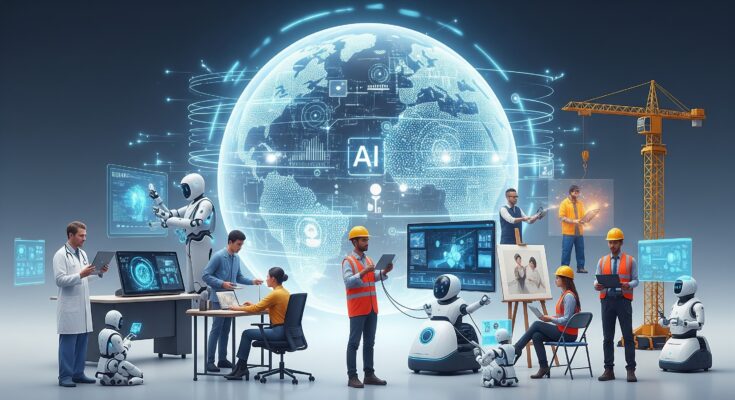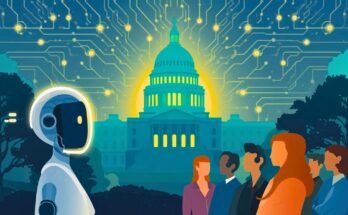The rapid development of artificial intelligence (AI) is ushering in a period of unprecedented change that is drastically transforming industries and the global workforce. A crucial question is raised as AI technologies advance and can now carry out tasks that were previously believed to be unique to humans: what will happen to human jobs in an AI-powered world? Beyond dramatic headlines, this blog post will examine the significant effects of AI on employment and offer a nuanced perspective on the opportunities and challenges that lie ahead. We will discuss how AI is requiring a reevaluation of human skills, automating repetitive tasks, and generating new job categories. To adapt and prosper in this changing environment, individuals, companies, and legislators must understand these changes.
The Changing Workplace: How Artificial Intelligence is Transforming Work in an AI-Powered World
AI’s integration into various industries is more than just a technical development; it represents a fundamental reinterpretation of work itself. This section will examine the primary ways that AI is impacting job roles, ranging from automation to augmentation. We will examine specifics from various industries to show these shifts.
Job Displacement and Automation: Recognizing At-Risk Positions
Automation-induced job displacement is one of the most talked-about effects of AI. Manufacturing, customer service, data entry, and even some analytical jobs will be automated as a result of AI’s proficiency with repetitive, data-intensive, and predictable tasks. This subsection will highlight common characteristics of jobs most at risk from automation, as well as provide examples of industries going through significant change. We’ll discuss how, despite the possibility of job losses in some sectors, this automation frees up human workers for more complex and creative tasks.
I as an Enhancer: Creating New Human-AI Collaborations
Even though automation frequently makes headlines, AI also functions as a potent tool for human augmentation. This section will look at how AI systems are improving human capabilities rather than replacing them. We’ll look at instances where AI helps professionals in fields including medicine, engineering, and creative arts make better decisions, increase productivity, and spur innovation. We’ll talk about how this paradigm change results in novel human-AI collaborative models, necessitating the acquisition of new skills for both people and organizations.
Redefining Skills: The Importance of Uniquely Human Attributes
As AI takes on more cognitive and routine tasks, the emphasis shifts to skills that are inherently human and difficult for machines to replicate. This section will explore the critical skills that will become increasingly valuable in an AI-powered world, such as creativity, critical thinking, emotional intelligence, complex problem-solving, and adaptability. We will discuss how educational systems and professional development programs need to evolve to cultivate these essential human attributes, preparing the workforce for future demands.
“The impact of AI-driven automation is not uniform across all sectors. Industries characterized by repetitive processes and readily digitizable data are experiencing the most significant shifts. This covers industries such as”
- Manufacturing: Assembly lines, quality assurance, and inventory management are being streamlined by robotics and artificial intelligence (AI). This is increasing efficiency, but in some cases, it is also reducing the need for manual labor.
- Customer service: Routine questions are being answered by chatbots and virtual assistants, freeing up human agents to handle more intricate or sympathetic client needs.
The Complexity of Losing a Job
Although the phrase “job displacement” frequently inspires anxiety, it’s important to comprehend the complex reality. Automation does not necessarily mean that jobs will be eliminated. Rather, it often results in a reinterpretation of roles and duties. Employees who have their tasks automated might be retrained for jobs requiring more human interaction, data analysis, or supervision of AI systems. Proactive adaptation and funding for reskilling programs are crucial.
The Transition to Value-Added Activities
The release of human potential for more intricate and imaginative pursuits is a major advantage of AI automating repetitive tasks. When employees are freed from monotonous tasks, they can concentrate on:
- Creating new business models, market strategies, and long-term visions is known as strategic planning.
- Developing new goods, services, and forms of artistic expression is known as innovation and design.
- Solving complex problems involves tackling difficult issues that call for human intuition, empathy, and critical thinking.
- Interpersonal relations include leadership, negotiating, and establishing and preserving relationships.
This shift highlights how important human-specific skills are becoming in an AI-enhanced workforce.
Common Questions Regarding AI and the Future of Employment
Q1: Will AI replace humans in every job?
A1: It’s more accurate to say that AI will transform jobs rather than completely replace them, even though it will automate a lot of repetitive tasks and displace some jobs. Human-AI collaboration will be incorporated into both new and evolving roles.
Q2: Which occupations are most vulnerable to automation by AI?
A2: Automation is most likely to affect jobs that require a lot of data, are highly repetitive, and have predictable tasks. Data entry, customer service, manufacturing, and some analytical positions are a few examples.
Q3: How can people get ready for how AI will alter the labor market?
A3: Individuals should concentrate on honing distinctively human abilities like creativity, critical thinking, emotional intelligence, adaptability, and complex problem-solving. Continuous learning and proactive reskilling will be essential.
Q4: Will AI lead to the creation of new jobs?
A4: It is anticipated that AI will lead to the creation of new job categories, especially in fields involving AI development, maintenance, and supervision, as well as positions that use human-AI cooperation to foster creativity and problem-solving.
Q5: In the context of AI, what does “human augmentation” mean?
A5: Rather than replacing professionals, “human augmentation” refers to how AI systems can improve human capabilities, assisting them in making better decisions, boosting productivity, and encouraging innovation.
Q6: How can artificial intelligence enhance human labor?
A6: AI helps with diagnosis and treatment planning in the medical field. It can optimize designs in engineering. It can give tools for coming up with new ideas or improving already-existing works in the creative arts.
Q7: How will an AI-powered world alter the need for human skills?
A7: Routine tasks will give way to abilities like strategic thinking, creativity, and interpersonal communication that are fundamentally human and hard for machines to imitate.
Q8: What role do businesses play in controlling how AI affects their employees?
A8: Companies must invest in reskilling and upskilling programs for their employees, foster a culture of continuous learning, and research new human-AI collaborative models.
Q9: How will educational systems change to prepare the future workforce for AI?
A9: Education systems must evolve to cultivate essential human attributes such as creativity, critical thinking, and emotional intelligence, as well as training in human-AI collaboration.
Q10: Does job displacement always result in job loss?
A10: Not always. While some jobs may be eliminated, job displacement frequently involves a reinterpretation of roles and responsibilities. Employees may be retrained for new roles that require more human interaction, data analysis, or supervision of AI systems.




